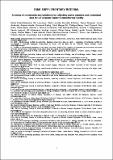Por favor, use este identificador para citar o enlazar a este item:
http://hdl.handle.net/10261/249265COMPARTIR / EXPORTAR:
 SHARE SHARE
 CORE
BASE CORE
BASE
|
|
| Visualizar otros formatos: MARC | Dublin Core | RDF | ORE | MODS | METS | DIDL | DATACITE | |

| Título: | A review of constraints and solutions for collecting raptor samples and contextual data for a European Raptor Biomonitoring Facility |
Autor: | Dulsat-Masvidal, María CSIC ORCID; Lourenço, Rui; Lacorte Bruguera, Silvia CSIC ORCID; D'Amico, Marcello CSIC ORCID; Albayrak, Tamer; Andevski, Jovan; Aradis, Arianna; Baltag, Emanuel; Berger-Tal, Oded; Berny, Philippe; Choresh, Yael; Duke, Guy; Espín, Silvia; García-Fernández, Antonio J.; Gómez-Ramírez, Pilar CSIC ORCID; Hallgrimsson, Gunnar T.; Jaspers, Veerle; Johansson, Ulf; Wernham, Chris | Palabras clave: | Ecotoxicology Environmental contaminants Long-term monitoring schemes Sampling constraints Sentinel species Top predators |
Fecha de publicación: | 1-nov-2021 | Editor: | Elsevier | Citación: | Science of the Total Environment 793: 148599 (2021) | Resumen: | The COST Action ‘European Raptor Biomonitoring Facility’ (ERBFacility) aims to develop pan-European raptor biomonitoring in support of better chemicals management in Europe, using raptors as sentinel species. This presents a significant challenge involving a range of constraints that must be identified and addressed. The aims of this study were to: (1) carry out a comprehensive review of the constraints that may limit the gathering in the field of raptor samples and contextual data, and assess their relative importance across Europe; and (2) identify and discuss possible solutions to the key constraints that were identified. We applied a participatory approach to identify constraints and to discuss feasible solutions. Thirty-one constraints were identified, which were divided into four categories: legal, methodological, spatial coverage, and skills constraints. To assess the importance of the constraints and their possible solutions, we collected information through scientific workshops and by distributing a questionnaire to stakeholders in all the countries involved in ERBFacility. We obtained 74 answers to the questionnaire, from 24 of the 39 COST participating countries. The most important constraints identified were related to the collection of complex contextual data about sources of contamination, and the low number of existing raptor population national/regional monitoring schemes and ecological studies that could provide raptor samples. Legal constraints, such as permits to allow the collection of invasive samples, and skills constraints, such as the lack of expertise to practice necropsies, were also highlighted. Here, we present solutions for all the constraints identified, thus suggesting the feasibility of establishing a long-term European Raptor Sampling Programme as a key element of the planned European Raptor Biomonitoring Facility. | Versión del editor: | https://doi.org/10.1016/j.scitotenv.2021.148599 | URI: | http://hdl.handle.net/10261/249265 | DOI: | 10.1016/j.scitotenv.2021.148599 |
| Aparece en las colecciones: | (IDAEA) Artículos (IREC) Artículos |
Ficheros en este ítem:
| Fichero | Descripción | Tamaño | Formato | |
|---|---|---|---|---|
| 1-s2.0-S0048969721036718-main.pdf | Artículo principal | 1,42 MB | Adobe PDF |  Visualizar/Abrir |
| 1-s2.0-S0048969721036718-mmc1.pdf | Material suplementario | 153,99 kB | Adobe PDF |  Visualizar/Abrir |
CORE Recommender
SCOPUSTM
Citations
7
checked on 13-abr-2024
WEB OF SCIENCETM
Citations
8
checked on 29-feb-2024
Page view(s)
69
checked on 16-abr-2024
Download(s)
173
checked on 16-abr-2024
Google ScholarTM
Check
Altmetric
Altmetric
Este item está licenciado bajo una Licencia Creative Commons

